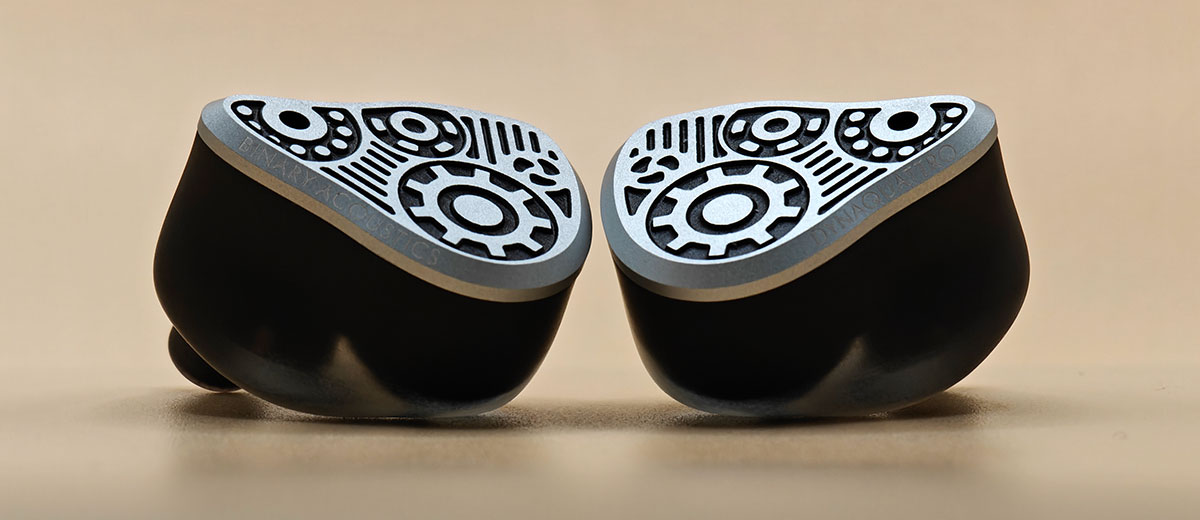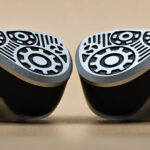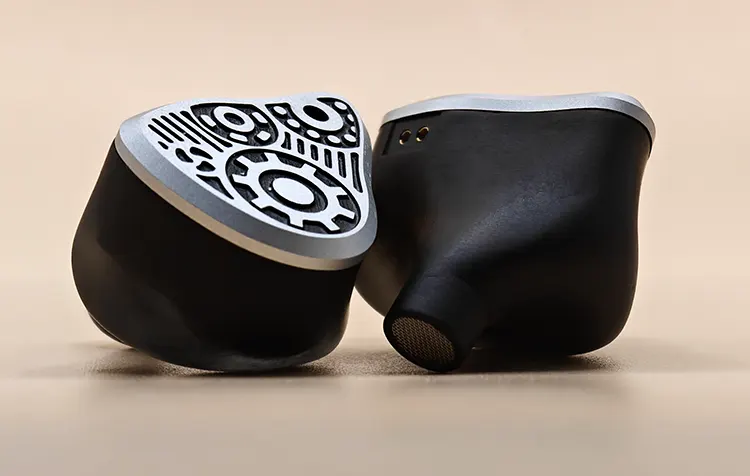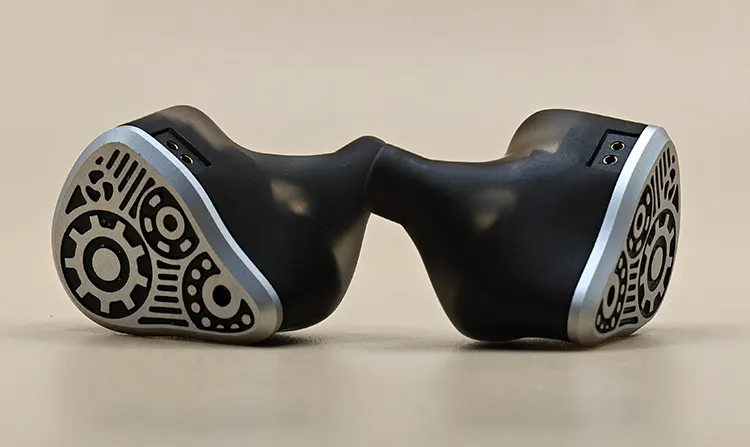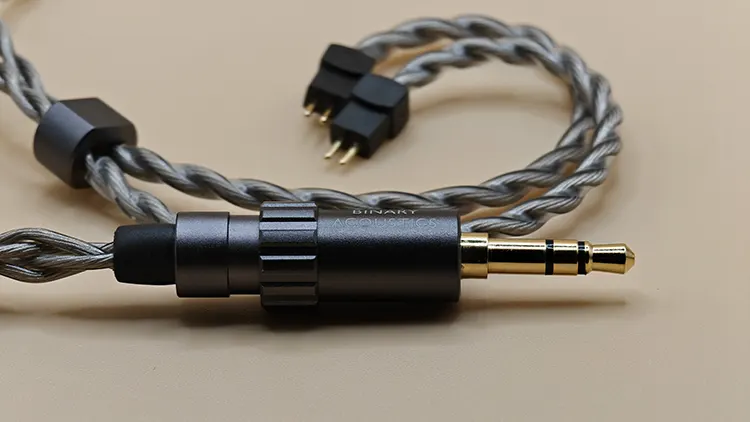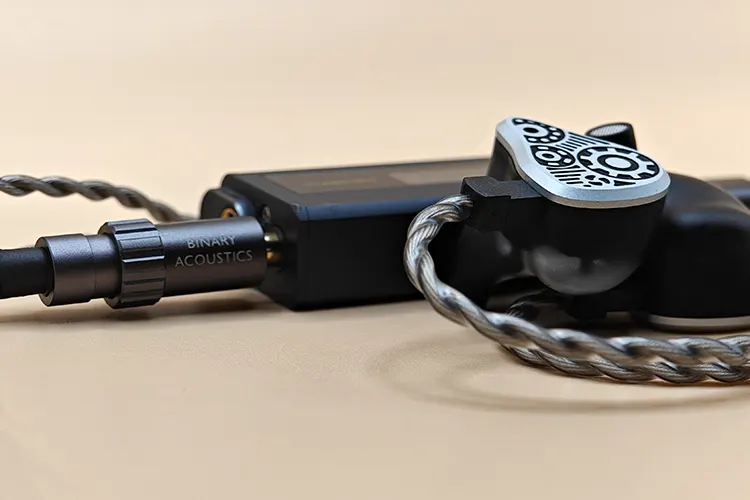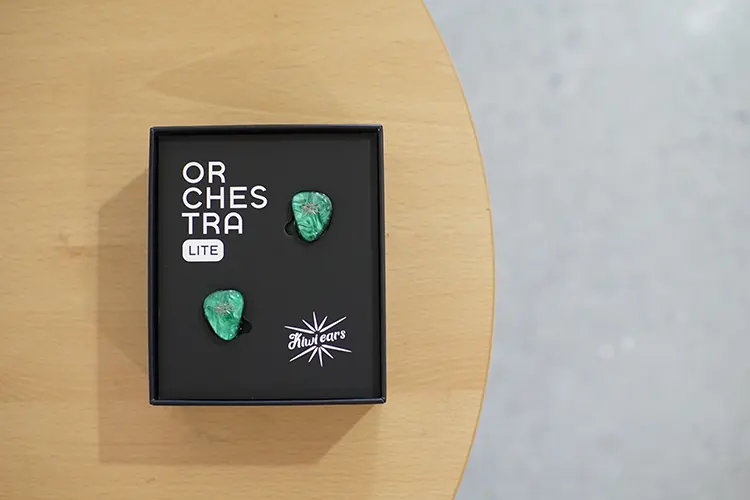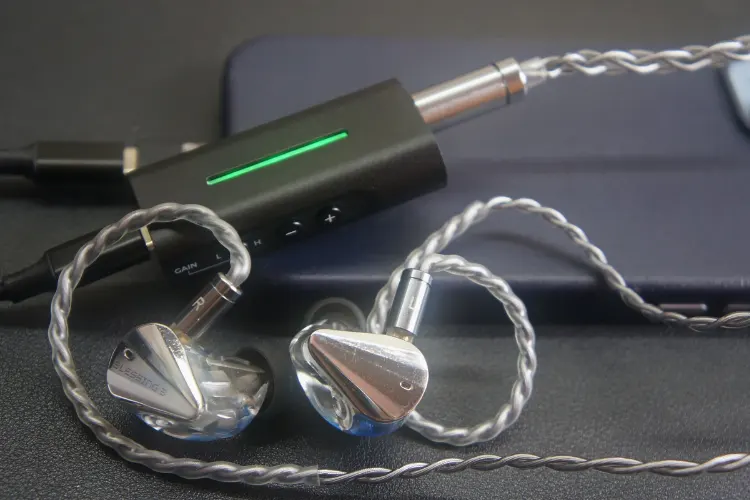In this feature, Kurt reviews the Binary Acoustics Dynaquattro, which is a new quad multi-sized dynamic driver universal IEM priced at $259.99.
Disclaimer: This sample was sent to me in exchange for my honest opinion. Headfonics is an independent website with no affiliate links or status. I thank HiFiGO and Binary Acoustics for their support.
Click here to read more on HiFiGO products that we have previously reviewed on Headfonics
Note that this article follows our latest scoring guidelines, which you can read in more detail here.
Binary Acoustics has been around since 2017 making audio products with a focus on using high-quality materials for comfort and luxury.
Some of their notable IEMs are the D1 Intro and D2 Outro as well as their bullet-style IEM called the EP1D.
Their recent collaboration with IEMs helped reintroduce their name to the modern audio community. Now they’ve made a unique and interesting 4 dynamic driver IEM called the Dynaquattro complete with their signature stylish Binary look.
We have previously reviewed quad dynamic driver IEMs such as the Oriolus Monachaa, however, that’s a high-end offering. The Dynaquattro is much more affordable at $259 but that does place it into a heavily saturated IEM price point.
I will be interested to see how it compares to established IEM brands in this review such as the MOONDROP Blessing 3 and the recent Kiwi Ears Orchestra Lite.
Features
The Binary Acoustics Dynaquattro is a universal multi-driver IEM featuring 4 dynamic drivers using a three-way crossover with independent acoustic tubes.
The dynamic drivers are all sized differently with 10mm, 8mm, 6.8mm, and 6mm drivers working in pairs. The fourth 6mm dynamic driver is more of a passive diaphragm similar to how a bone conduction driver works.
The 10mm dynamic driver is responsible for the bass and lower ends. This is paired up with the 6mm passive diaphragm to give that proper bass experience while the material used for it is titanium-coated and wool paper cone respectively.
Meanwhile, the 6.8mm and 8mm dynamic drivers handle the higher frequencies like the mids, treble, and air region. The material used for this dynamic driver duo is made of high-rigidity aluminum.
Design
The Binary Acoustics Dynaquattro is a premium and stylish IEM with its CNC aluminum finish. That faceplate gives me some science-fiction vibes which I like.
That gear’s design is laser-carved onto its aviation-grade aluminum alloy faceplate that went through a double anodizing process giving it a sticky and rough feel when touched.
There’s also the word Dynaquattro finely etched on the side of the right IEM. The left one doesn’t have any other engravings or etching.
Unlike its unique faceplate design, the shell is something we’ve seen numerous times in high-end IEMs. It’s similar to the faceplate of the Moondrop Variations in shape, size, and opaqueness.
One thing I did notice is that the Dynaquattro seems to be a ventless IEM. I could not find vents to alleviate pressure from these 4 dynamic drivers. The other observation is that the nozzle has no lip. Some tips tend to slip off it and be left in your ear.
Comfort & Isolation
The fit and comfort of wearing the Dynaquattro isn’t that good. Its large shell isn’t the best choice for all people. Letting my brother, who has smaller ears, wear it gave him trouble. The IEMs were hanging and barely inside his ears.
Someone like me with larger ears won’t have issues with it though. I can fit it but it’s not comfortable at all. Tip rolling didn’t fix this as well. Unfortunately, having to accept the discomfort was the answer to this.
Isolation is a strong point though. No matter the tips used, this had a similar passive noise cancellation as some of my budget TWS.
The Binary Acoustics Dynaquattro’s tip selection is unlike the rest of its premium experience. They have a typical powdery finish to their silicone tips with a single black finish and no other options to try out.
Stock Cable
The Binary Acoustics Dynaquattro has an impressive 4-wire high-purity oxygen-free copper with silver plating stock cable, terminated modular-style with 4.4mm and 3.5mm terminations included.
What’s unique with this modular cable is how you switch the terminations. There’s a gear knob here that you loosen to unplug the 3.5mm or 4.4mm terminations.
The Dynaquattro-branded chin slider articulates nicely with a smooth feeling when adjusting and hardly any stubborn resistance or sliding when using the cable.
Packaging & Accessories
The Binary Acoustics Dynaquattro offers a good unboxing experience.
The box branding is strong on the outer with a striking gear illustration consistent with the IEM shell design theme. On its back is the tuning of the Dynaquattro along with some technical information.
Opening it, we’re greeted with a shiny Binary Acoustics coversheet over the IEMs pre-connected to its cable. Below there is a hard carrying case similar in styling to a Pelican design.
The tips, manual, and 4.4mm jack are inside that carrying case. Aside from the underwhelming tip selection, everything else was provided with a lot of thought and appreciation from Binary.
Sound Impressions
Bass
The is the crème de la crème of the Dynaquattro with a superb bass peformance.
The sub-bass is where Binary Acoustics hit the mark incredibly well. It is potent and strong but never overwhelming to the extent that everything else gets overshadowed by it.
Its bass has a lot of detail and texture with a subtle and precise rumbling aided by the passive driver when the lower frequencies are presented.
There is not as much focus on the midbass though I wouldn’t say it’s flat sounding and lacking in punch. Despite not giving as much love as the subbass, the midbass still has some warmth and presence which helps give the midrange a more natural tone.
Overall, the bass slam is powerful but not overwhelming. As a result, I suspect purists will take more to the Dynaquattro low-end tuning over out and out bassheads.
Mids
With the Dynaquattro not using BA or planar drivers, there is a natural cohesiveness present in its midrange timbre.
The timbre is exceptionally natural, probably the most natural and accurate among its competitors. Having zero shoutiness or peakiness helps to achieve a lush and enjoyable midrange.
The dynamic driver provides female and male vocals with a consistently thick and adequately warm tonal balance without a loss in microdetail. The Dynaquattro excels with male vocals which are particularly rich and detailed.
Clarity is surprisingly good with impressive and realistic instrumental and vocal separation. Nothing sounds congested so I can easily pick up on individual instruments and backing vocals imaging and placement.
Treble
The treble of the Dynaquattro isn’t the most detailed I’ve heard. It could use more detail retrieval and sparkle in this regard since it isn’t impressive.
But that’s me nitpicking when in reality it has good enough detail retrieval and can compete with some of my planar IEMs such as the 7Hz Timeless.
The upside to this is the lack of sibilance. Even testing it with sibilant tracks, vocal harmonics rarely sounded ruffled or unbalanced.
It’s a reasonably airy set of highs and a region that is not overcooked in presence to create a false impression of adequate headroom. Overall, its treble is smooth, well-defined, and safe.
Staging & Dynamics
The staging of the Dynaquattro is wide, but nothing too impressive. It gave me a spacious experience, which is better than most, but it’s not the widest and most immersive staging I’ve tested.
The imaging is where it does things better. It has top-notch positioning and placement of instruments, vocals, and details of the track.
Using it with games is a great choice. Its controlled and excellent bass paired with accurate imaging helped with my gaming experience.
On the other hand, dynamics are properly managed. Despite being heavy on the sub-bass, the treble helps tame it down and control its dynamics.
Synergy
Efficiency
The Binary Acoustics Dynaquattro’s impedance rating of 23Ω with a sensitivity of 111dB/mW makes it seem easy to run on paper. In reality, the Dynaquattro requires something more powerful than a laptop or phone 3.5mm jack.
With its 4 dynamic drivers, this is a beast to power for an IEM. It also drinks power from my 3.5mm capable phone. My usage of it has been with its 4.4mm balanced jack. This gave it the necessary power it needed.
Pairings
I’ve used the Binary Acoustics Dynaquattro with different devices and dongles. I’ve used it for both inside and outside usage.
My outside experience of using it was with its 3.5mm jack, my phone, and the FiiO JA11 dongle. Despite using a dongle or my phone directly, I had battery issues with the Dynaquattro eating at its battery.
I brought a power bank for this, which is the only solution I had. Unfortunately, I couldn’t test DAP usage with it.
Meanwhile, my indoor experience involves using the IEMs with my computer, laptop, and the Colorfly CDA-M2. I only used it with the 4.4mm balanced jack with this testing.
I put my laptop at 100% volume and my Colorfly CDA-M2 at 40% volume here. The volume levels show how power-hungry the Dynaquattro is.
Select Comparisons
Kiwi Ears Orchestra Lite
Technical
The Kiwi Ears Orchestra Lite has an 8 BA driver setup with dual subwoofer balanced armatures for the bass, 4 custom BA for the mids, and 2 custom BA tweeters for the highs.
It has a 16Ω impedance and a 112 dB sensitivity which makes it fairly easy to run. I wouldn’t worry about needing a stronger source or going balanced with this IEM.
Design
The Kiwi Ears Orchestra Lite has a faceplate similar to a guitar pick. Its numerous color choices make this point even stronger.
It comes in a lot of colors so we’re spoiled for choice here. We have blue, green, purple, yellow, and white colors available.
The Kiwi Ears name is printed on the faceplate as well. It’s written in a shiny yellow color. The shell has a classic transparent look so all the drivers can be seen directly under good lighting conditions.
Performance
The Dynaquattro has a very strong advantage with its bass response sounding much beefier compared to the the Orchestra Lite.
Going from Dynaquattro to Orchestra Lite, I instantly felt the lack of sub-bass and slam. The music I was listening to sounded drier after the change.
The weaker sub-bass from the Orchestra Lite was noticeable. I wasn’t getting the bass impact that was satisfying and powerful.
The mids are also a different story. The vocal tonality they go for is opposites of each other. The Dynaquattro’s vocals are more natural with the correct timbre it should have. Meanwhile, the Orchestra Lite follows a more analytical and detail-heavy vocal take.
The Orchestra Lite’s vocals have a sharpened tone that isn’t natural sounding at all. I will admit they are more detailed sounding compared to the Dynaquattro but at the expense of a leaner note quality.
The treble of these two is quite similar. They both have a musical and non-fatiguing treble that most would enjoy. However, the Dynaquattro has a smoother, more consistent treble performance with no sibilance and peakiness while the Orchestra Lite still has those issues.
For soundstage and imaging, the Orchestra Lite has more of an in-head experience. It isn’t as immersive sounding with the imaging a level below the Dynaquattro performance.
Moondrop Blessing 3
Technical
The Moondrop Blessing 3 has a more normal hybrid driver setup. It has 2 dynamic drivers and 4 balanced armatures inside.
The dual dynamic drivers with their H.O.D.D.D.U.S. system power the bass response. The 4 BA drivers are split between the mids and treble.
It has a 14.8Ω impedance and 120 dB/Vrms sensitivity, similar to the previous Blessing series. This makes it sensitive enough for pairing with almost any dongle or DAC.
Design
The Moondrop Blessing 3 has a minimalistic design but strays away from those matte black looks by retaining aspects of the previous Moondrop Blessing 2 design language.
It has that large transparent shell that reveals the drivers. The change this time is with the stainless-steel faceplate.
This is a fingerprint magnet though, so beware of that. There’s a vent on top of the plate with either the word Moondrop or Blessing 3 engraved.
Performance
The Moondrop Blessing 3 and the Binary Acoustics Dynaquattro both have dynamic drivers to handle their bass, so one would expect a close comparison but it isn’t.
The Blessing 3’s bass is significantly weaker than the Dynaquattro equivalent. With how it handles bass rumble, it doesn’t hold a candle to the controlled and excellent sub-bass of the Dynaquattro.
I found it difficult to get a feel for not only the Blessing 3’s sub-bass but also the mid-bass. This heavily skews its midrange performance as well.
The mids are thin and too analytical in comparison. The Blessing 3’s timbre sounds unusual due to that lack of midbass while its vocals are borderline shouty.
The Dynaquattro has adequately thick mids with a natural timbre for vocals. Adding to that, it sounds more musical than analytical which makes it better for laid-back listening sessions.
The treble is where the Blessing 3 comes back to fight with one of the best detail retrievals I have heard from an IEM though it will seem comparatively brighter as a result.
The Dynaquattro’s detail retrieval sounds lacking in comparison. I missed the added zing and sparkle whenever I would use the Blessing 3.
For the soundstage and imaging, they’re surprisingly on par with each other. They both have a wide soundstage with accurate imaging that’s on top of the competition.
My Verdict
Binary Acoustics has created a very competitive IEM that doesn’t feel lacking from the unboxing experience to the tuning.
I would say, however, that non-bassheads will enjoy the Dynaquattro a lot more than out-and-out bassheads. It reaches deep and is very impressive but the controlled bloom keeps the lows from becoming too dominant.
With its 4 dynamic drivers and cool visual exterior, the Dynaquattro is a unique IEM at its price point and one that I would consider a dark horse IEM with impressive technical capability and pleasing tuning.
Binay Acoustics Dynaquattro Technical Specifications
- Driver Type: One (1x) 10mm, 8mm, 6.8mm dynamic driver, one (1x) 6mm passive diaphragm
- Plug: Modular 3.5mm unbalanced, 4.4mm balanced
- Frequency Response: 20Hz – 20kHz
- Impedance: 23@1kHz
- Sensitivity: 111db/Vrms

